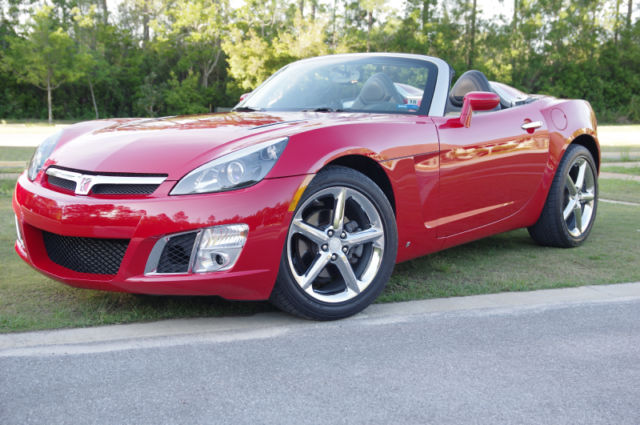

Both received very high marks on their styling from reviewers and the public.

The interiors were no less exciting, with far more design than most GM products in recent memory. The Pontiac was curvaceous and muscular, while the Saturn was razor sharp and edgy. The Solstice and Sky were twins under the skin, but they had very different looks. Leather seating was a popular choice for both cars. Both cars could be loaded up with OnStar, satellite radio, upgraded audio and chrome wheels if the buyer wanted. The Saturn-branded Sky included most of these as standard, but otherwise it was almost identical in spec. Air conditioning power windows, mirrors and door locks and remote entry were all optional, as were a four-wheel ABS and improved sound deadening. True to its sports car roots, the base Solstice had few standard features. The standard differential was an open unit, though a limited-slip differential was available separately or as part of the Pontiac’s “Club Sport” package, which also included four-wheel ABS and different suspension tuning.
SATURN SKYLINE MANUAL
It was backed by either a five-speed manual Aisin transmission or a five-speed automatic. The Sky and Solstice shared a common engine: a 2.4-liter, 173-horsepower LE5 variant of the GM Ecotec similar to the one used in the Cobalt and various other GM vehicles at the time. The Sky shared its appearance with two other variants of the car–the only-in-Korea Daewoo G2X and the European-market Opel GT. This was the Saturn Sky roadster–basically the same car as the Solstice, but with a different front and rear fascia and a slightly different interior. It even had the distinction of being the first GM vehicle with adjustable rear caster.Ī fraternal twin was shown shortly after the launch of the Solstice on the 2006 auto show circuit. All four corners featured a short-long-arms suspension with unique control arms and uprights. The chassis featured a rigid backbone frame, with a deep tunnel and hydroformed frame rails that GM claimed gave it rigidity without depending on a roof structure for strength. It was clear where engineers spent the most time and money. Looking past all the cost cutting, including the rather heavy-handed use of hard interior plastics and “leatherette,” the Kappa platform was more akin to the Corvette than anything else. Even the GMC Envoy, Opel Corsa and Fiat Barchetta were parts donors according to GM, giving the Solstice backup lights, seat frames and sideview mirrors, respectively. The Cadillac CTS donated a differential and automatic transmission, while other bits came from the Hummer H3, Chevy Colorado, Cadillac XTS and Cobalt/G5. The car was built on an all-new compact rear platform, dubbed Kappa, but relied heavily on parts borrowed from other GM vehicles to control costs. The interior looked great, and the whole package was appealing on paper.Īll the key design features from the concept carried over into the 2004 unveiling of the production Solstice. It had a more aggressive wheel-and-tire package than the Japanese offering–as well as less refined styling. It was a convertible two-seater that was more than a little reminiscent of the Mazda Miata, with small exterior dimensions, a four-cylinder engine, and a rear-wheel-drive powertrain. The Solstice concept was one of the best-received, shown first in 2002. Results included the Holden-built GTO, along with a number of concepts displayed at auto shows to judge consumer reactions. Pontiac was slated to become an enthusiast division, with new rear-drive replacements for aging products and more fun-to-drive products in general. One of the company’s first moves was to put Oldsmobile out to pasture.Ĭadillac was the first to benefit from this strategy with the launch of the successful rear-wheel-drive CTS, reversing a trend toward front-drive products in every other division. One of the keys to more sales was more engaging products, and Lutz set out to streamline the number of nameplates and models so that more development money could be spent on more profitable segments. GM had recently brought in head product guy Bob Lutz to invigorate the company’s numerous brands. GM leadership had to do something, or continue to fall behind Toyota in the American sales race. The Camaro and Firebird were dead, SUVs and trucks ruled the product mix, and car line innovation was sorely lacking. Most of the company’s brands were in disarray, and buyers were deserting by the thousands. The early 2000s were tumultuous years for GM.


 0 kommentar(er)
0 kommentar(er)
